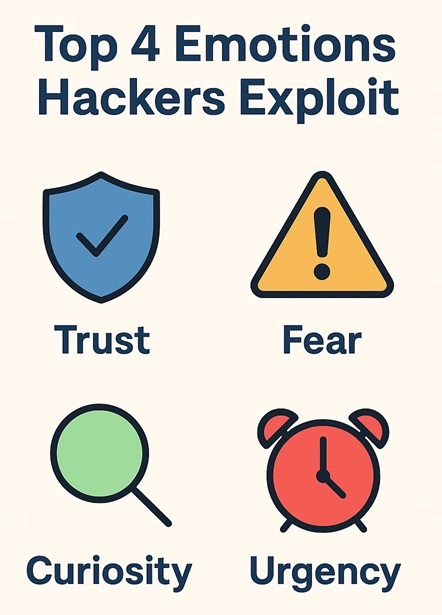How Hackers Hack Your Mind (Not Just Your Computer)
Understanding the psychological tactics cybercriminals use to bypass even the strongest technical defenses
When you hear about a cyberattack, you might imagine a hooded coder furiously breaking into a secure server. While that happens, most hackers don't bother with brute-force attacks. They know the truth: it's easier to hack a person than a machine.
This strategy is called social engineering — the art of manipulating human psychology to gain access to confidential information. Hackers exploit trust, fear, urgency, and curiosity, because the weakest link in cybersecurity is often not technology but human behavior. As we discuss in our article on why cyber awareness matters more than ever, understanding these psychological tactics is crucial for your digital safety.
The Psychological Tools of a Hacker
Hackers don't always need sophisticated malware. Instead, they use mind tricks to convince you to hand over the keys. Here are the most common tactics:

Common emotional triggers that hackers exploit in social engineering attacks
You receive an email that looks like it's from your bank: "Your account will be suspended in 24 hours unless you verify your details."
The email includes a link to a fake login page, where your username and password are quietly stolen. Learn more about these attacks in our detailed guide on phishing attacks and how to spot them.
Why it works: Fear + urgency override rational thinking.
A caller pretends to be from your internet service provider: "We've detected suspicious activity on your network. Can you confirm your account details so we can fix it?"
Because they sound official and the story feels urgent, you comply. This is one of the most common digital mistakes people make.
Why it works: We tend to trust authority figures and want problems solved quickly.
While browsing, you see: "Download this free movie!" or "Exclusive discount if you sign up now!"
Clicking installs malware or leads you into a scam that steals your credit card details. Maintaining good cyber hygiene habits can help you avoid these traps.
Why it works: Curiosity and reward-seeking behavior cloud judgment.
An attacker poses as IT support: "I can fix your technical issue immediately—just give me your login details so I can access your system."
The employee thinks they're getting help, but in reality, they're handing over the keys. This is particularly dangerous in business settings, as discussed in our article on cyber awareness for small businesses.
Why it works: Reciprocity — when someone offers help, we feel compelled to cooperate.
Modern Twists You Should Know
Hackers are evolving their psychological playbook, using techniques that are covered in our evolving threat landscape report:
- AI Voice Cloning: Scammers can mimic your boss's or family member's voice, urgently asking for money or access.
- QR Code Phishing: Fake QR codes on posters, restaurants, or parking meters lead to malicious sites.
- Deepfake Job Interviews: Attackers pose as recruiters, conducting video calls with AI-generated faces, then tricking candidates into sharing sensitive info.
The tactics may change, but the psychology behind them is always the same. For protection against these threats, consider the advice in our threats & mitigation guide.
Quick Quiz: Spot the Trick
Which of these is most likely a hacker's trap?
- An email from HR about updated annual leave policy.
- A LinkedIn message from a recruiter offering a job with an attached PDF.
- A friend forwarding you a funny cat video link.
✅ Answer
#2. Fake job offers are a growing social engineering scam. While any of these could potentially be malicious, job offers with attachments are increasingly being used in targeted attacks, especially on professional networks like LinkedIn. Test your knowledge further in our interactive Quiz Lab.
Real-World Lesson: The LinkedIn Job Scam
Recently, attackers ran a large-scale campaign using fake job offers on LinkedIn. The messages looked professional and often included "resumes" or "job details" as attachments.
When victims opened these files, malware was silently installed, giving hackers access to their systems. This is similar to the threats we discuss in our article on modern authentication methods.
Takeaway: Even trusted platforms like LinkedIn aren't safe from manipulation. Always verify unexpected offers or attachments before clicking.
Your Best Defense Is a Human One
Firewalls and antivirus software can only go so far. The real defense starts with awareness, as we explain in our guide on building a culture of cyber awareness at home.
- Pause and Verify: Don't act on urgency. Always double-check senders.
- Trust Your Gut: If something feels off, it probably is.
- Never Rush: Hackers thrive on forcing quick decisions.
- Stay Informed: The more scams you recognize, the less likely you are to fall for them.
By practicing these habits, you become a hard target — even for sophisticated attackers. For additional protection, consider implementing a proper firewall setup for your home network.
Final Word: Outsmart the Hackers
Hackers don't just hack machines — they hack minds. But once you understand their tricks, you take away their power. Combine this knowledge with the practical steps in our practical guides section to create a comprehensive defense strategy.
Think you can spot a social engineering attack?
Head over to our Quiz Lab and put your skills to the test.
 Access Deny
Access Deny